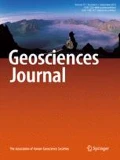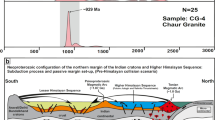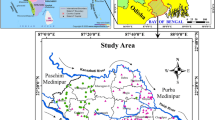Abstract
The aim of this paper is to review the results of the assessment of low-temperature geothermal resources (issue temperatures between 41 and 77 °C) that occur in the Portuguese mainland. For this purpose, a multidisciplinary approach, including geologic, tectonic, geochemical, geophysical and isotopic (δ2H, δ18O, δ13C, 3H and 14C) techniques, was applied in order to update local and/or regional conceptual circulation models. Three case studies of N-Portugal are presented and discussed. This paper describes different low-temperature geothermal waters presenting similar hydrogeological conceptual models but rather different geochemical signatures (e.g., HCO3-Na with pH ≈ 8, HCO3/Na/CO2-rich with pH ≈ 7 and HCO3-Na with pH ≈ 9, type waters). In fact, in the studied low-temperature geothermal systems, local/regional high altitude sites associated with highly fractured rocks play an important role in conducting the infiltrated meteoric waters towards the discharge zones near the Spas. The discharge zones are mainly related to the intersection of major regional fault lineaments (and conjugate structures), responsible for creating the mineral waters ascent. In some cases, geochemical and isotopic data point out to the existence of anthropogenic contamination of some geothermal spring waters related to the intense use of fertilizers in areas of widespread agricultural practices.
Similar content being viewed by others
References
Aires-Barros, L., Graça, R.C., and Marques, J.M., 1994, The low temperature geothermal system of Chaves (Northern Portugal): a geochemical approach. Document du Bureau de Recherches Géologiques et Minières, 230, 67–73.
Aires-Barros, L., Marques, J.M., and Graça, R.C., 1995, Elemental and isotopic geochemistry in the hydrothermal area of Chaves / Vila Pouca de Aguiar (Northern Portugal). Environmental Geology, 25, 232–238.
Aires-Barros, L., Marques, J.M., Graça, R.C., Matias, M.J., Weijden, C.H. van Der, Kreulen, R., and Eggenkamp, H.G.M., 1998, Hot and cold CO2-rich mineral waters in Chaves geothermal area (Northern Portugal). Geothermics, 27, 89–107.
Almeida, F.M., 1982, New geotermometric data on Chaves and S. Pedro do Sul waters. Comunicações dos Serviços Geológicos de Portugal, 68, 179–190. (in Portuguese).
Andrade, M.P.L., 2003, Isotopic geochemistry and thermomineral waters. Contribution of Sr (87Sr/86Sr) and Cl (37Cl/35Cl) isotopes to the elaboration of circulation models. The case of some CO2-rich waters from N Portugal. MSc Thesis, Technical University of Lisbon (IST), 104 p. (in Portuguese with English abstract).
Arnórsson, S., 1975, Application of the silica geothermometer in low-temperature hydrothermal areas in Iceland. American Journal of Science, 275, 763–784.
Arthaud, F. and Matte, Ph., 1975, The southwestern European Late Variscan strike-slip shear faults: geometric pattern and deformation conditions. Tectonophysics, 25, 139–171. (in French with English abstract).
Baptista, J., Coke, C., Dias, R., and Ribeiro, A., 1993, Tectonics and geomorphology of Pedras Salgadas region and associated mineral springs. In: Chambel, A. (ed.), Comunicações da XII Reunião de Geologia do Oeste Peninsular, Évora University, 1, 125–139. (in Portuguese).
Baptista, J., Cabral, J., and Ribeiro, A., 1998, Seismotectonics of Chaves and Moledo mineral springs in Penacova-Régua-Verin Fault Zone. In: Azerêdo, A. (ed.), Actas do V Congresso Nacional de Geologia, Comunicações do Instituto Geológico e Mineiro, Lisbon, 84, 69–72.
Bergfeld, D., Goff, F., and Janik, C.J., 2001, Carbon isotope systematics and CO2 sources in the Geysers-Clear Lake region, northern California, USA. Geothermics, 30, 303–331.
Bernardo de Sousa, M. and Sequeira, A.J.D., 1989, Geological report on the Alijó Sheet No. 10-D (1:50,000). Portuguese Geological Survey, Lisbon, 59 p. (in Portuguese).
Cabral, J., 1989, An example of intraplate neotectonic activity Vilariça Basin, Northeast Portugal. Tectonics, 8, 285–303.
Cabral, J., 1995, Neotectonics in Portuguese mainland. Memórias do Instituto Geolológico e Mineiro, Lisbon, 31, 1–265. (in Portuguese with English abstract).
Carreira, P.M., Barbosa, T., Valério, P., and Araújo, M.F., 2003, Tritium values in precipitation waters in Portuguese mainland: variability and constraint factors. In: Proceedings of Resumos do IV Congresso Ibérico de Geoquímica. XIII Semana de Geoquímica, 353–355. (in Portuguese).
Carreira, P.M., Marques, J.M., Andrade, M., and Nunes, D., 2004, Groundwater flow patterns in Caldas de Monção thermomineral systems evaluated from isotopic and geochemical data — NW Portugal. In: UNESCO-IAEA (eds.), Proceedings of the International Workshop on the Application of Isotopes in Hydrological and Environmental Studies, 47.
Carreira, P.M., Marques, J.M., Carvalho, M.R., Monteiro Santos, F.A., Matias, H., Luzio, R., and Nunes, D., 2006, Fluid/mineral equilibrium calculations and chemical geothermometry of Monção thermal waters (NW-Portugal): a tool to estimate the deep thermal waters composition. In: Bureau de Recherches Géologiques et Minières (ed.), Abstracts of the International Symposium on Aquifer Systems Management (+ CD with Full Texts), Theme 4, 4–15.
Carreira, P.M., Marques, J.M., Carvalho, M.R., Capasso, G., Grassa, F., Antunes da Silva, M., and Matias, M.J., 2007, Genesis of CO2-rich mineral waters (N-Portugal) inferred by geochemistry and isotopes ratios in water and gas phases. In: Ribeiro, L., Chambel, A., and Condesso de Melo, T. (eds.), Abstract Book of the XXXV IAH Congress, International Association of Hydro-geologists, Groundwater and Ecosystems, 549–550.
Carreira, P.M., Marques, J.M., Graça, R.C., and Aires-Barros, L., 2008, Radiocarbon application in dating “complex” hot and cold CO2-rich mineral water systems: a review of case studies ascribed to the northern Portugal. Applied Geochemistry, 23, 2817–2828.
Carvalho, J.M., 1996, Mineral water exploration and exploitation at the Portuguese Hercynian Massif. Environmental Geology, 27, 252–258.
Carvalho, J.M., Chaminé, H.I., Afonso, M.J., Espinha Marques, J., Medeiros, A., Garcia, S., Gomes, A., Teixeira, J., and Fonseca, P.E., 2005, Productivity and water costs in fissured-aquifers from the Iberian crystalline basement (Portugal): hydrogeological constraints. In: López-Geta, J.A., Pulido Bosch, A., and Baquero Úbeda, J.C. (eds.), Water, Mining and Environment, Book Homage to Professor Rafael Fernández Rubio, Instituto Geológico y Minero de España, Madrid, 193–207.
Clarke, I.D. and Fritz, P., 1997, Environmental isotopes in hydrogeology. Lewis Publishers, New York, 327 p.
Craig, H., 1961, Standard for reporting concentrations of deuterium and oxygen-18 in natural waters. Science, 133, 1833–1834.
Craig, H., 1963, The isotopic geochemistry of water and carbon in geothermal areas. In: Tongiorgi, E. (ed.), Nuclear Geology in Geothermal Areas, Consiglio Nazionale delle Ricerche, Laboratorio di Geologia Nucleare, Pisa, 17 p.
D.G.R.A.H, 1986, Hydrologic papers on the main river waters of Portuguese mainland. Directorate General of Water Resources, Lisbon, 569 p. (in Portuguese).
Dickson, M.H. and Fanelli, M., 2003, Geothermal background. In: Dickson, M.H. and Fanelli, M. (eds.), Geothermal Energy, Utilization and Technology, UNESCO, Paris, 1–25.
Duque, R., Monteiro Santos, F.A., and Mendes-Victor, L.A., 1998, Heat flow and deep temperatures in the Chaves Geothermal system, northern Portugal. Geothermics, 27, 75–87.
Ellis, A.J., 1970, Quantitative interpretation of chemical characteristics of geothermal systems. Geothermics, Special Issue, 2, 516–528.
Epstein, S. and Mayeda, T., 1953, Variation of 18O content of waters from natural sources. Geochimica et Cosmochimica Acta, 4, 213–224.
Espinha Marques, J., Marques, J.M., Chaminé, H.I., Gomes, A.A., Fonseca, P.E., Carvalho, J.M., Carreira, P.M., Graça, R.C., Aires-Barros, L., and Borges, F.S., 2003, Poço Quente thermal spring (Granjão-Caldas do Moledo, Northern Portugal): morphostructure, geochemistry and hydrogeology. Cadernos Laboratorio Xeolóxico de Laxe, 28, 147–172.
Forster, C. and Smith, L., 1988, Groundwater flow systems in mountainous terrain 2: controlling factors. Water Resources Research, 24, 1011–1023.
Forster, C. and Smith, L., 1989, The influence of groundwater flow on thermal regimes in mountainous terrain: a model study. Journal of Geophysical Research, 94, 9439–9451.
Fouillac, C., 1983, Chemical geothermometry in CO2-rich thermal waters. Example of the French Massif Central. Geothermics, 12, 146–160.
Fouillac, C. and Michard, G., 1981, Sodium/lithium ratio in water applied to geothermometry of geothermal reservoirs. Geothermics, 10, 55–70.
Fournier, R.O., 1977, Chemical geothermometers and mixing models for geothermal systems. Geothermics, 5, 41–50.
Fournier, R.O. and Rowe, J.J., 1996, Estimation of underground temperatures from the silica content of water from hot springs and wet-steam wells. American Journal of Science, 264, 685–697.
Fournier, R.O. and Truesdell, A.H., 1973, An empirical Na-K-Ca geothermometer for natural waters. Geochimica et Cosmochimica Acta, 37, 1255–1275.
Fournier, R.O. and Potter II, R.W., 1979, Magnesium correction to the Na-K-Ca chemical geothermometer. Geochimica et Cosmochimica Acta, 43, 1543–1550.
Friedman, I., 1953, Deuterium content of natural waters and other substances. Geochimica et Cosmochimica Acta, 4, 89–103.
Giggenbach, W.F., 1988, Geothermal solute equilibria — Derivation of Na-K-Ca-Mg geoindicators. Geochimica et Cosmochimica Acta, 52, 2749–2765.
Griffith, D.H. and Barker, R.D., 1993, Two-dimensional resistivity imaging and modelling in areas of complex geology. Journal of Applied Geophysics, 29, 211–226.
Haenel, R. and Hurter, S., 2002, Atlas of geothermal resources in Europe. Commission of the European Communities, Brussels, Luxemburg, 91 p. and 89 plates.
I.A.E.A., 1976, Procedure and technique critique for tritium enrichment by electrolysis at IAEA laboratory. Technical Procedure No. 19, International Atomic Energy Agency, Vienna.
I.A.E.A., 1981, Stable Isotope Hydrology. Deuterium and Oxygen-18 in the Water Cycle. IAEA, Vienna. Technical Reports Series, 210, 340 p.
Loke, M.H. and Barker, R.D., 1996, Rapid least-squares inversion of apparent resistivity pseudosections by a quasi -Newton method. Geophysical Prospecting, 44, 131–152.
López, D.L. and Smith, L., 1995, Fluid flow in fault zones: analysis of the interplay of convective circulation and topographically driven groundwater flow. Water Resources Research, 31, 1489–1503.
Loureiro, J.J.M., Macedo, M.E.Z., Almeida, M.C.L., and Martins, J.C.S., 1986, The catchment of Douro River. In: D.G.R.A.H (ed.), Hydrologic papers on the main river waters of Portuguese mainland, 147–205. (in Portuguese).
Mahon, W.A.J., 1966, Silica in hot water discharged from drillholes at Wairakei, New Zealand. New Zealand Journal of Science, 9, 135–144.
Marini, L. and Susangkyono, A.E., 1999, Fluid geochemistry of Ambon Island (Indonesia). Geothermics, 28, 189–204.
Marques, J.M., Carreira, P.M., Aires-Barros, L., and Graça, R.C., 1998, About the origin of CO2 in some HCO3/Na/CO2-rich Portuguese mineral waters. Geothermal Resources Council Transactions, 22, 113–117.
Marques, J.M., Aires-Barros, L., and Graça, R.C., 1999a, Geochemical and isotopic features of hot and cold CO2-rich mineral waters of northern Portugal: a review and reinterpretation. Bulletin d’Hydrogéologie, 17, 175–183.
Marques, J.M., Aires-Barros, L., and Graça, R.C., 1999b, Isotopic and chemical signatures of low-temperature sulphurous mineral waters (northern Portugal): preliminary results. Geothermal Resources Council Transactions, 23, 327–332.
Marques, J.M., Carreira, P.M., Aires-Barros, L., and Graça, R.C., 2000, Nature and role of CO2 in some hot and cold HCO3/Na/CO2-rich Portuguese mineral waters: a review and reinterpreta tion. Environmental Geology, 40, 53–63.
Marques, J.M., Monteiro Santos, F.A., Graça, R.C., Castro, R., Aires-Barros, L., and Mendes Victor, L., 2001, A geochemical and geophysical approach to derive a conceptual circulation model of CO2-rich mineral waters: a case study of Vilarelho da Raia, northern Portugal. Hydrogeology Journal, 9, 584–596.
Marques, J.M., Espinha Marques, J., Carreira, P.M., Graça, R.C., Aires-Barros, L., Carvalho, J.M., Chaminé, H.I., and Borges, F.S., 2003, Geothermal fluids circulation at Caldas do Moledo area, Northern Portugal: geochemical and isotopic signatures. Geofluids, 3, 189–201.
Marques, J.M., Monteiro Santos, F.A., Andrade M., Carreira, P.M., Andrade Afonso, A., Dupis, A., Graça, R.C., Aires-Barros, L.A., and Mendes Victor, L.A., 2005, Conceptual modelling of the nature of complex thermomineral systems/CO2-rich waters (N-Portugal): a review on the geochemical and geophysical approaches. Geothermal Resources Council Transactions, 29, 277–281.
Marques, J.M., Andrade, M., Carreira, P.M., Eggenkamp, H.G.M., Graça, R.C., Aires-Barros, L., and Antunes da Silva M., 2006, Chemical and isotopic signatures of HCO3/Na/CO2-rich geofluids, North Portugal. Geofluids, 6, 273–287.
Monteiro Santos, F.A., Dupis, A., Andrade Afonso, A.R., and Mendes-Victor, L.A., 1995, Magnetotelluric observations over the Chaves geothermal field (NE Portugal) — preliminary results. Physics of the Earth and Planetary Interiors, 91, 203–211.
Monteiro Santos, F.A., Dupis, A., Andrade Afonso, A.R., and Mendes-Victor, L.A., 1996, An audiomagnetotelluric survey over the Chaves geothermal field (NE Portugal). Geothermics, 25, 389–406.
Monteiro Santos, F.A., Andrade Afonso, A.R., and Mendes-Victor, L.A., 1997, A study of Chaves geothermal field using 3D resistivity modelling. Journal of Applied Geophysics, 37, 85–102.
Moreira, A. and Simões, M., 1988, Geological report on the Arcos de Valdevez Sheet No. 1-D (1:50,000). Portuguese Geological Survey, Lisbon, 48 p. (in Portuguese).
Nascimento, I.B., 2000, Contribution to the knowledge of ground-waters from Monção region. MEng Thesis, Technical University of Lisbon, Instituto Superior Técnico, 92 p. (in Portuguese with English abstract).
Navas, J.R., 1978, Geological Map of Spain, Salvatierra de Miño Sheet (1:50,000) 262/5-12. Geological and Mining Institute of Spain. (in Spanish).
Oliveira, J.T., Pereira, E., Ramalho, M., Antunes, M.T., and Monteiro, J.H., 1992, Geological Map of Portugal (1: 500,000), 5th edition, Portuguese Geological Survey, Lisbon. (in Portuguese).
Pedrosa, M.Y., 1999, Hydrogeological Map of Portugal (1: 200,000). Report on the Sheet 1, Mining and Geological Institute, Department of Hydrogeology, 70 p. (in Portuguese).
Pérez-Alberti, A., García-García, H., and Gomes A., 2010, The terrace staircase in the lower section of the Miño river near Ourense (Galicia, Spain): climate variability or tectonic dynamic? In: Proceedings of FLAG’2010 Biennial Meeting on Long term river evolution and fluvial dynamics, Vila Velha de Rodão, p. 11.
Pérez, N.M., Nakai, S., Wakita, H., Albert-Bertrán, J.F., and Redondo, R., 1996, Preliminary results on 3He/4He isotopic ratios in terrestrial fluids from Iberian Peninsula: seismoctectonic and neotectonic implications. Geogaceta, 20, 830–833.
Pereira, E., Ribeiro, A., Marques, F., Munhá, J., Castro, P., Meireles, C., Ribeiro, M.A., Pereira, D., Noronha, F., and Ferreira, N., 1989, Geological Map of Portugal (1:/200,000), sheet 2, Portuguese Geological Survey, Lisbon. (in Portuguese).
Portugal Ferreira, M., Sousa Oliveira, A., and Trota A.N., 1992, Chaves geothermal pole. Geological Survey, I and II. Joule I Program, DGXII, CEE. UTAD (University of Trás-os-Montes and Alto Douro, Portugal), Internal Report, 44 p.
Ribeiro, M.L. and Moreira, A., 1986, Geological Report on the Monção Sheet No. 1-B (1:50,000). Portuguese Geological Survey, Lisbon, 46 p. (in Portuguese).
Ribeiro, A., Kullberg, M.C., Kullberg, J.C., Manuppella, G., and Phipps, S., 1990, A review of Alpine tectonics in Portugal: foreland detachment in basement and cover rocks. Tectonophysics, 184, 357–366.
Ribeiro, A., Munhá, J., Dias, R., Mateus, A., Pereira, E., Ribeiro, L., Fonseca, P.E., Araújo, A., Oliveira, J.T., Romão, J., Chaminé, H.I., Coke, C., and Pedro, J., 2007, Geodynamic evolution of the SW Europe Variscides. Tectonics, 26, TC6009, DOI: 10.1029/2006TC002058.
Rozanski, K., Araguás-Araguás, L., and Gonfiantini, R., 1993, Isotopic patterns in modern global precipitation. American Geophysical Union, Geophysical Monograph, 78, Climate Change in Continental Isotopic Records, 1–36.
Salem, O., Visser, J.M., Deay, M., and Gonfiantini, R., 1980. Groundwater flow patterns in western Lybian Arab Jamahitiya evaluated from isotope data. In: I.A.E.A (ed.), Arid zone hydrology: investigations with isotope techniques, 165–179.
Smith, L. and Chapman, D.S., 1983. On the thermal effects of groundwater flow: 1. Regional scale systems. Journal of Geophysical Research, 88, No. B1, 593–608.
Sousa Oliveira, A. and Portugal Ferreira, M.R., 1995, Structural control of the hydromineral springs from Pedras Salgadas region (Vila Pouca de Aguiar — Northern Portugal). Memória, Porto University (mineralogy-geology laboratory and museum), 4, 485–489. (in Portuguese).
Sousa Oliveira, A. and Portugal Ferreira M.R., 1996, The structure of the cross graben — horst system of the Pedras Salgadas — Vidago region (northern Portugal): framework of the associated hydromineral springs. In: Proceedings of the 3rd Congresso da Água / VII SILUBESA, Lisboa, Portugal, 3, 123–130 (in Portuguese).
Teixeira, C., Fernandes, A.P., and Peres, A., 1967, Geological report on the Peso da Régua Sheet No. 10-C (1:50,000). Portuguese Geological Survey, Lisbon, 60 p. (in Portuguese).
Teixeira, C. and Cândido de Medeiros, A., 1974, Geological report on the Chaves Sheet No. 6-B (1:50,000). Portuguese Geological Survey, Lisbon, 35 p. (in Portuguese).
Truesdell, A.H., 1975, Geochemical techniques in exploration. In: Proceedings of the 2nd United Nations Symposium on the Development and Use of Geothermal Resources, San Francisco, 1, 53–79.
Truesdell, A.H. and Hulston, J.R., 1980, Isotopic evidence on environments of geothermal systems. In: Fritz, P. and Fontes, J.Ch. (eds.), Handbook of Environmental Isotope Geochemistry. The Terrestrial Environment, Vol. 1, 179–226.
Vicente, G. and Vegas, R., 2009, Large-scale distributed deformation controlled topography along the western Africa Eurasia limit: tectonic constraints. Tectonophysics, 474, 124–143
Welch, A.H., Sorey, M.L., and Olmsted F.H., 1981, The hydrothermal system in southern Grass Valley, Pershing County, Nevada. U.S. Geological Survey, Open-File Report, 81-915.
Zhdanov, M.S. and Keller, G.V., 1994, Electrical methods in geophysical exploration. Amsterdam, Elsevier, 929 p.
Author information
Authors and Affiliations
Corresponding author
Rights and permissions
About this article
Cite this article
Marques, J.M., Carreira, P.M., Marques, J.E. et al. The role of geosciences in the assessment of low-temperature geothermal resources (N-Portugal): a review. Geosci J 14, 423–442 (2010). https://doi.org/10.1007/s12303-010-0034-0
Received:
Accepted:
Published:
Issue Date:
DOI: https://doi.org/10.1007/s12303-010-0034-0




